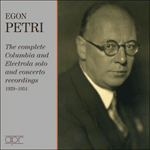
Welcome to Hyperion Records, a British classical label devoted to presenting high-quality recordings of music of all styles and from all periods from the twelfth century to the twenty-first.
Hyperion offers both CDs, and downloads in a number of formats. The site is also available in several languages.
Please use the dropdown buttons to set your preferred options, or use the checkbox to accept the defaults.
When playing a Beethoven sonata it is important to remember how new and different this music sounded when it was first heard. Op 10 No 2 is basically a comedy, set up by the two chords and the throw-away turn at the very beginning. Of course we sense the presence of Haydn, but Beethoven was never anyone other than himself. After the development section of the first movement, in which another turn figure refuses to disappear, the music comes to a brief pause, making us wonder what will happen next. Beethoven teasingly gives us the recapitulation in the wrong key—D major—adding a whole new colour to the mix. But then he sneaks back to the tonic and brings this fun movement to a brilliant close.
The second movement, Allegretto, was initially conceived as a minuet and trio. Perhaps the title was changed because the repeat of the ‘minuet’ is quite varied and the whole thing not very dance-like. The middle section in D flat major makes us momentarily wonder if we are not listening to Schubert rather than to Beethoven. But the characteristic szforzandos couldn’t be by anyone else.
The finale seems to fuse Haydn’s mischievousness and Bach’s counterpoint, but with an exuberance typical of the young Beethoven. A hint of D major reminds us of his first movement high jinks, before hurtling us to the final unison F. Tovey writes that ‘a scrambling performance of this movement is among the ugliest experiences in music, and is permanently hurtful to the technique and style of the scrambler’. To be convincingly ‘bustling and merry’ (as Czerny describes this movement) one must unfortunately also be able to play the notes!
from notes by Angela Hewitt © 2010
Quand on joue une sonate de Beethoven, il faut se rappeler combien cette musique parut nouvelle et différente à ceux qui l’entendirent pour la première fois. Foncièrement, la Sonate op. 10 no 2 est une comédie, lancée par les deux accords et par le gruppetto désinvolte du tout début. On sent, naturellement, la présence de Haydn, mais Beethoven ne fut jamais que lui-même. Après le développement du premier mouvement où une autre figure de gruppetto refuse de disparaître, la musique en vient à marquer une courte pause, et l’on se demande alors ce qui va bien pouvoir arriver. Beethoven, taquin, nous offre la réexposition dans la fausse tonalité—ré majeur—, ajoutant au mélange une toute nouvelle couleur. Mais ensuite, il retrouve en douce la tonique pour clore brillamment cet amusant mouvement.
Le deuxième mouvement, Allegretto, fut d’abord conçu comme un menuet et trio, le changement de titre venant peut-être de ce que la reprise du «menuet» est très variée et de ce que l’ensemble n’est guère dansant. La section centrale en ré bemol majeur nous fait même nous demander, l’espace d’un instant, si nous ne sommes pas en train d’écouter du Schubert plutôt que du Beethoven. Mais les sforzandos caractéristiques ne pouvaient être de personne d’autre. Le finale semble fusionner l’espièglerie de Haydn et le contrepoint de Bach, mais avec une exubérance typique du jeune Beethoven. Un relent de ré majeur nous rappelle le chahut du premier mouvement, avant de nous entraîner dans le fa final à l’unisson. Selon Tovey, «une interprétation précipitée de ce mouvement est l’une des plus mauvaises expériences musicales, constamment préjudiciable à la technique et au style de qui se précipite». Pour être, de manière convaincante, «animé et joyeux» (c’est ainsi que Czerny dépeint ce mouvement), il faut aussi, hélas, pouvoir jouer les notes!
extrait des notes rédigées par Angela Hewitt © 2010
Français: Hypérion
Wenn man eine Beethovensonate spielt, muss man sich klarmachen, wie neu und anders diese Musik geklungen haben muss, als sie erstmals aufgeführt wurde. Diese Sonate ist komödiantisch angelegt—sie ist auf den beiden Anfangsakkorden mit der darauffolgenden wegwerfenden, kreisartigen Geste aufgebaut. Natürlich kann man hier Haydns Einfluss spüren, doch war Beethoven stets eigenständig. Nach der Durchführung des ersten Satzes, in dem eine weitere kreisartige Figur nicht verschwinden will, erreicht die Musik eine kurze Pause, so dass man sich fragt, was wohl als Nächstes kommen könnte. Beethoven neckt seine Hörer und lässt die Reprise in der falschen Tonart (D-Dur) erklingen und sorgt damit für völlig neue Klangfarben. Doch dann führt er durch das Hintertürchen die Tonika wieder ein und bringt diesen heiteren Satz zu einem brillanten Ende.
Der zweite Satz, Allegretto, war zunächst als Menuett und Trio angelegt. Vielleicht wurde der Titel geändert, weil die Wiederholung des „Menuetts“ recht unterschiedlich ausfällt und das Ganze nicht sonderlich tanzartig klingt. Im Mittelteil, der in Des-Dur steht, könnt man fast den Eindruck haben, dass es sich hier um Schubert und nicht Beethoven handelt. Doch können die charakteristischen Sforzandi nur von Beethoven stammen.
Im Finalsatz scheinen Haydns Verschmitztheit und Bachs Kontrapunkt miteinander zu verschmelzen, jedoch mit der charakteristischen Überschwänglichkeit des jungen Beethoven. Ein Anklang an D-Dur erinnert uns an die Figuren des ersten Satzes, bevor die Musik auf das F-Unisono am Ende hinzurast. Tovey schreibt, dass eine „holperige Aufführung dieses Satzes eine besonders hässliche musikalische Erfahrung“ sei und „zudem der Technik und dem Stil des Holperers nachhaltig schade“. Um den Satz überzeugend darzustellen—laut Czerny „macht er im schnellen Tempo eine brillante Wirkung“—muss man leider auch die Noten spielen können!
aus dem Begleittext von Angela Hewitt © 2010
Deutsch: Viola Scheffel
 Beethoven: Beethoven Unbound Beethoven: Beethoven UnboundA comprehensive new cycle of the Beethoven sonatas recorded live at London's Wigmore Hall during the pianist's epic fourth rendition of these masterpieces .» More |
 Egon Petri - The complete Columbia and Electrola solo and concerto recordings Egon Petri - The complete Columbia and Electrola solo and concerto recordingsEgon Petri (1881-1962) studied with Busoni and was perhaps his greatest disciple. In his fusion of intellect with an astonishing virtuoso technique he echoed his master and gives us today the clearest idea of Busoni’s own legendary pianism.» More |

